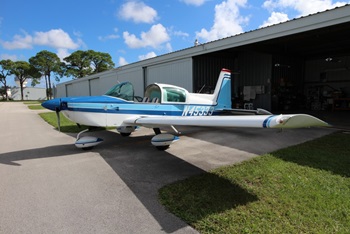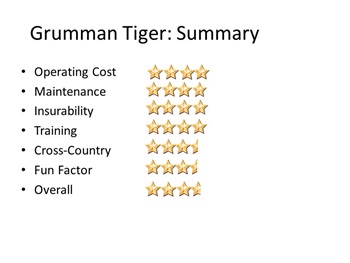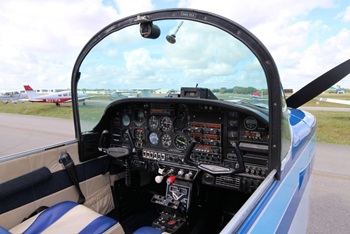The Aircraft Spotlight feature looks at an airplane type and evaluates it across six areas of particular interest to flying clubs and their members: Operating Cost, Maintenance, Insurability, Training, Cross-Country, and Fun Factor.
 When the Flying Educators, an equity club with a Citabria based at Ft. Lauderdale Executive Airport (KFXE) [see this month’s Club Spotlight], wanted an airplane better suited for cross-country travel they settled on the Grumman AA5B Tiger. “It was largely a matter of economics,” Club Secretary and Treasurer Greg Utley said. The most popular of the Grumman series that began with the two-seat Yankee in the late 1960s, the Tiger seats four, has a 180-hp engine, and burns 10 gph. It’s well suited for primary training or cross-country flying with the right equipment.
When the Flying Educators, an equity club with a Citabria based at Ft. Lauderdale Executive Airport (KFXE) [see this month’s Club Spotlight], wanted an airplane better suited for cross-country travel they settled on the Grumman AA5B Tiger. “It was largely a matter of economics,” Club Secretary and Treasurer Greg Utley said. The most popular of the Grumman series that began with the two-seat Yankee in the late 1960s, the Tiger seats four, has a 180-hp engine, and burns 10 gph. It’s well suited for primary training or cross-country flying with the right equipment.
Operating Cost (4 stars)
“With a Tiger, the term ‘Bang for the Buck’ comes to mind because it’s an airplane that can probably get the most speed for the least cost,” Greg said. “And that was the main consideration.”
The specs list the cruise speed at 139 knots, but Greg said the Flying Educators usually fly on economy cruise and get 115 kts to 120 kts ground speed while the 180-hp Lycoming O360 burns 10 gph. They charge $90 an hour, Tach time, wet.
Grumman produced the AA5B Tiger from 1975 through 1979, and then American General produced the AG5B Tiger from 1991 through 1993. Similar four-seat Grummans include the 150-hp AA5 Traveler and AA5A Cheetah, and the 160-hp GA7 Cougar.
Prices for the mid-70s Tigers range from $35,000 for a VFR-equipped aircraft with an engine nearing TBO to about $60,000 for a better equipped model. The American General Tigers produced in the 1990s will cost a bit more with prices in the $75,000 to $100,000 range.
 Maintenance (4 stars)
Maintenance (4 stars)
“It’s a fixed gear, fixed-pitch prop, so there’s just not a whole lot that can go wrong with the airplane,” Greg noted. “We haven’t had any major problems with the Tiger.” The club has a mechanic that does the maintenance on the aircraft, so Greg wasn’t sure what an annual would traditionally cost, but the club hasn’t run into any problems and it has owned Tigers since 1995.
Although the airplane hasn’t been manufactured for quite some time, Greg said parts are easy to get. “The main parts supplier for Grumman aircraft is an outfit called FletchAir, and I think they’re based in Houston,” he said. “They can provide anything for the airplane—wheels, wheel pants, windshields, cowlings, anything you need for a Tiger or like Grumman aircraft—they can provide.”
Insurability (4 stars)
Flying Educators have never had a problem getting insurance for the Tiger. The club uses Avemco and pays $6,000 a year, but Greg noted that Florida is an expensive state to insure an aircraft because of hurricanes and the fact the state is highly litigious. The hull is insured at $65,000 with $1 million liability. They have an unnamed policy, meaning they don’t have to list their members or their flight time, so anyone who joins the club is insured. Greg noted on a named policy, you’ll pay a premium based on your least experienced pilot.
Training (4 stars)
Flying Educators requires members to already have their Private Pilot Certificate, but Greg would recommend the aircraft as a primary trainer. With a fixed-pitch prop and fixed gear, it’s simple to operate. However, “you have to mind your Ps & Qs,” Greg noted, “because it’s going to respond faster to control inputs than a typical trainer.”
It also has a free-castering nose wheel so steering is accomplished through differential braking, which takes a little more skill than a traditional aircraft with nose wheel steering. “The first time someone gets into an airplane like that and you’re taxiing with a crosswind, you want to drag the brake to keep it going straight,” Greg said. “After a while you get to the point were you learn to tap the brake instead of dragging the brake and to get the airplane up to a taxi speed that will give the rudder enough effectiveness so that it won’t weather vane into the wind.”
Cross-Country Travel (3.5 stars)
 The reason Flying Educators switched to the Tiger after owning only Citabrias for 30 years is so members could do more cross-country flying. “You’re going to get more airspeed out of a Tiger than you get out of most four-place aircraft in that category,” Greg said. “And a little more economically.” Being based in Florida, there are many destinations within a 500-mile radius, including the Bahamas, and members wanted an aircraft more suited to that mission.
The reason Flying Educators switched to the Tiger after owning only Citabrias for 30 years is so members could do more cross-country flying. “You’re going to get more airspeed out of a Tiger than you get out of most four-place aircraft in that category,” Greg said. “And a little more economically.” Being based in Florida, there are many destinations within a 500-mile radius, including the Bahamas, and members wanted an aircraft more suited to that mission.
It holds 52 gallons and has a range of about 700 miles. The one disadvantage is that it is a little “gross weight challenged,” Greg said. With full fuel, the payload is about 500 pounds or so – plenty if two people are flying with luggage. If you have four people, filling up to the tabs provides 38 gallons of fuel, which should be fine.
The Flying Educator’s Tiger has a two-axis autopilot so it frequently goes out IFR. If you have a Tiger without the autopilot, it’s not going to be quite as stable as a 172 or a 182. “If you have an autopilot, it’s a wonderful cross country bird,” Greg said.
Fun Factor (3.5 stars)
For a club with a 30-year history flying only Citabrias, the members were used to something light and agile on the controls. Moving to the Grumman Tiger meant they could have a four-place aircraft better suited for cross-country travel and still have a plane that was responsive. It’s roll rate is faster than a Piper or Cessna.
“Everybody was used to flying Citabrias, which, as you know, are fully aerobatic,” Greg said. “The Tiger is halfway between a sport plane and a Cessna 172. It’s very responsive. If you fly a Tiger for 20 or 30 hours and get into a Cessna 172, it literally feels like a truck.”
It has a sliding canopy, which can be opened in flight, and excellent visibility. The bonded aluminum construction eliminates the need for rivets, so even sitting on the ground it looks sleek.
Overall (3.8 stars)
If your club is looking for an economical aircraft that can serve as a primary trainer and a solid cross-country platform with good performance, the Grumman Tiger is a plane you may want to consider. It’s nimble in the air, seats four and has a good cruising speed for minimal fuel burn. But at the end of the day, Greg noted that most members fly solo or with only one passenger and for that reason “the airplane has to be fun to fly, and it is.”